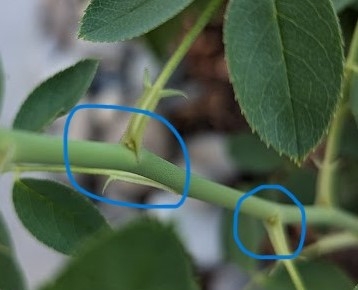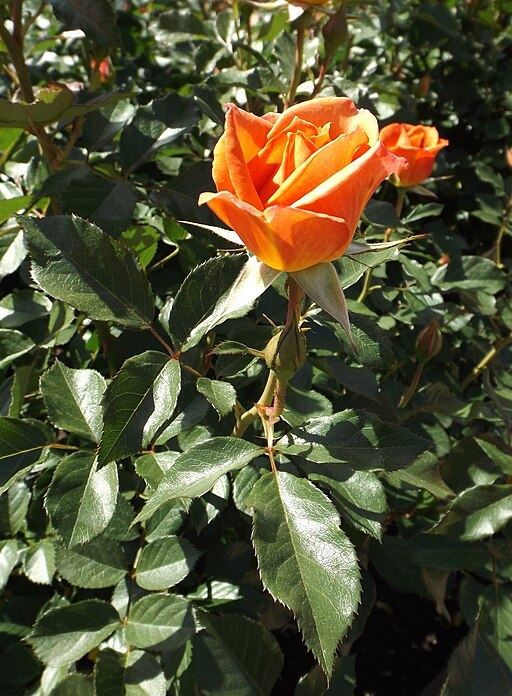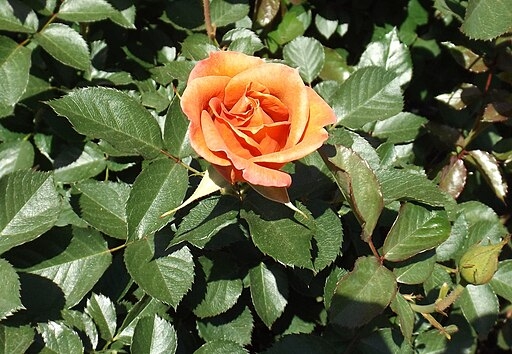Are you ready for autumn to begin and be done with the heat of the summer? I am looking forward to the fall and it can start anytime in my book! However, looks like we are (still) in for warmer than “normal” temperatures for the foreseeable future.

So, what to do in the rose garden this month? Towards the middle of the month, you can lightly prune your roses. This is not the major pruning you will do in February. Instead, you can cut any spent flowers or hips to the next set of leaflets that have either five or seven leaves. (Some roses have five leaves on their leaflets and other varieties have seven.)
This is a light trim only. Prune by cutting ¼ inch to ½ inch above an outward-facing bud eye. What is a bud eye? It is the small bump found where the leaf meets the stem/cane on the rose bush. If any canes have died during this summer (hint - they are black all the way to the soil), clip those off at the base. Only trim a maximum of 1/3 of the overall size of the bush.
If you see that by trimming the bush, there will be very little foliage left on it, don't trim it at all. Leave it alone and see how the rose bush looks in the spring. Having no foliage on your rose bush is the quickest way to kill it. What typically happens is that, when a rose is cut back with no foliage on it during this time of year, the canes will turn black and the plant slowly dies. I learned this lesson the hard way, when I first started growing roses many years ago. The safest thing is to leave your roses alone if trimming them will leave no foliage on them at all.
Again, always make sure your pruning shears are sharp and clean. Wipe with an alcohol wipe between each rose bush. Don't use bleach on your pruning shear blades as it can damage them. The alcohol wipe won't, and it will kill any diseases on the blade so they don't affect your rose bushes.
If your roses are on drip irrigation, run your system in the early morning or evening (on the days we can water) to give your roses a chance to thoroughly hydrate. Check your irrigation system to see that it is operating correctly and none of the emitters are clogged. If an emitter is delivering more or less water than the other emitters on the line, change it out for a new one. That one emitter can affect the whole system. Replace it when there is a problem.
If you grow roses in pots, make sure that they are getting enough water. If the soil has pulled away from the pot, water can run through the pot but not hydrate your plant. Make sure your potting soil allows water to get to the plant. You should re-pot your roses every couple of years. The longer the soil is in a pot, the less porous it becomes in the root zone. New soil would be in order. Don't do this now. Wait and put this on your spring chore list when your rose is dormant.
Towards the middle of the September, it is time to feed your roses. You can use a rose food (8-10-8), liquid fish or seaweed fertilizer and alfalfa meal. If the fish fertilizer smells like fish and you have a lot of neighborhood cats, you may want to use the seaweed fertilizer instead.
Alfalfa meal (not the pellets which contain sugar/molasses and can attract rodents) contains a chemical called triacontanol. It will stimulate new growth in your roses. Make sure you water the bushes before you add the alfalfa meal. Add about a cup of alfalfa meal to the soil for large, established roses and about a ½ cup for large, established mini roses. Water again afterward. Never fertilize a dry or stressed plant.
If you are using an organic rose fertilizer, apply the recommended amount (it is on the label), after the 15th of the month. You can also put down some compost. Make sure you water after putting down the fertilizer. If you wish to use liquid fish/seaweed fertilizer, mix according to the package directions. You can do this every other week up until the middle of November. Then it will be time to start giving your plants a rest for a nice bloom next spring. You should have lovely blooms for Thanksgiving, and I even have had lovely blooms for Christmas (depending on the weather).
It is still important to watch out for spider mites. You can hose those off with a good blast of water and make sure to blast the underside of the leaves as well. It is still too hot to use horticultural oil. You will burn your plants.
Pumpkin Patch roses


Until next time . . . "Autumn leaves don't fall, they fly. They take their time and wander on this their only chance to soar." - Delia Owens, "Where the Crawdads Sing"